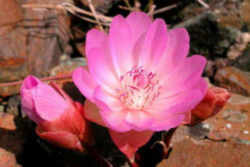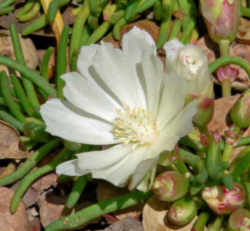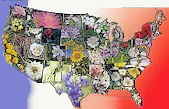
Montana Symbols
Montana State Flower (Floral Emblem)
Bitterroot

(Lewisia rediviva)
Adopted on February 27, 1895 .
The bitterroot, (Lewisia rediviva,) was adopted on February 27, 1895 as Montana state flower, a beautiful purplish-pink flower.
Delegates to the 1889 Montana Women's Christian Temperance Union, meeting in Missoula, selected a "little blue flower that grows near the snow banks" as the WCTU's official state flower. Two years later, sentiment arose for change and the bitterroot received the WCTU's designation. A perennial, the bitterroot has an exquisite pink blossom which grows close to the ground and its delicate shadings offer the eye one of the loveliest of wildflowers.
Montana State Flower: Bitterroot
History of the Bitterroot

The bitterroot (Lewisia Rediviva) was a logical historical choice. In 1805, Meriwether Lewis and William Clark "discovered" the plant in the western Montana valley that now bears its name.
Long before explorers Lewis and Clark wrote about the beautiful purplish-pink flower of the bitterroot, Native Americans were using its roots for food and trade. Tribes dug up the roots and dried them so they could be kept and used for months. The root was too bitter to eat unless it was cooked, and it was usually mixed with berries or meat. An Indian story tells how the bitterroot came to be. It says the sun heard a mother crying because she couldn't find food for her family. The sun changed her tears into the bitterroot so she would always have food for her children. You can find the bitterroot growing near the mountains and boulders of western Montana in spring and summer. Mice love its leaves and seeds.
A decade before the Spanish American War colored Montana's seal, a more subdued movement began to add beauty and a mild fragrance to Montana's list of symbols.
Montana's Indians used it as an important part of their diet. Tribes timed their spring migrations with the blooming of the bitterroot on the gravel river bars and hillsides. Dug, cleaned, and dried, the root provided a lightweight, nutritious supplement to a wild-game diet. At major trading centers like The Dalles, the root was an item of barter and exchange. A sack full commanded a substantial price-usually a horse.
One ounce of dried root provided sufficient nourishment for a meal, but the plant was seldom eaten raw, for its bitter taste and resultant swelling caused great discomfort. More traditionally, Indian women boiled the root, then mixed it with meat or berries. Pulverized and seasoned with deer fat and moss, the cooked root could be molded into patties and carried on hunting expeditions or war parties.
With a strong Indian heritage and a name derived from the leader of the Lewis and Clark expedition, the bitterroot was most appropriate as a state symbol. In their contribution to the 1893 Columbia Exposition, Butte residents used the flower as the central figure on a large silver shield. That same year, in response to a national WCTU program, Mrs. Mary Long Alderson of Bozeman began efforts to secure legislative designation for the bitterroot as Montana's state flower.
Mary Alderson was the heart of the state flower movement in Montana. In January of 1894, she formed and headed Montana's Floral Emblem Association. County and community committees followed, as did floral meetings in most major cities and towns. The association set a state-wide referendum for fall. Interested men and women registered in their respective counties. Mrs. Alderson's committee then sent out a ballot to each registrant. Ballots had to be completed and returned by September 1, 1894.
Montana's press joined in the effort. Columns described the cause and the floral candidates. Editorials advocated this flower or that. When the polls closed, 5,857 ballots were in. More than 32 separate flowers received votes. The winner (with 3,621 votes) was the bitterroot, followed by the evening primrose (787 votes) and the wild rose (668). At Mrs. Alderson's urging, the 1895 Legislature responded to public preference and sanctioned the symbol.
Before long the delicate petals of the bitterroot graced stationery, posters, silverware, and even special sets of double damask Irish linen. The major credit for the addition of the bitterroot to Montana's list of official symbols belongs to Mary Long Alderson.
Identification of the Bitterroot
Perennial with flowers that are rose-pink, and 2 inches across in May and. June. It has narrow, red-green leaves that form basal rosette in early spring. The leaves die back in June. Plants are located from British Colombia to San Bernardino Mountains to Rocky Mountains. The plant is not alkali tolerant, and needs good drainage. The peeled, boiled root may be eaten, and the plant protect from birds until established. It is an excellent showy plant at higher elevations or in the East. It has a tendency to rot in the winters at lower elevations because of wet conditions.
- Flowers: Bitterroots white to pinkish flowers, each about two inches across appear to be leafless. But the fleshy, one to two inch leaves appear before the flowers in early spring, soon after the snow melts. They wither away by the time the flowers bloom, generally in early June. One flower per scape; 4 to 9 sepals; 10 to 19 petals, 18 to 35 mm, white to rose colored; 40 to 70 stamens
- Blooms: May to June
- Leaves: Basal, thick, succulent; without margins of flattening of top and bottom surfaces; leaves either present at anthesis or withering and drying by then
- Plant: Perennial. Traditionally the roots were peeled, then cooked and eaten, or dried for future use by the Coeur d'Alene, Kutenai, Okanagon-Coville, Okanagon, Sanpoil, Shuswap, Spokan, and Thompson.
- Habitat: Loose gravel and rocky places, sandy ground, granite or shale, mostly dry soil, sagebrush plains to lower mountains
The Montana Code
The law designating the bitterroot as the official Montana state floral emblem is found in the Montana Code, Title 1, Chapter 1, Part 5, Section 1-1-503.
TITLE 1. GENERAL LAWS AND DEFINITIONS.
CHAPTER 1. GENERAL PROVISIONS.
Part 5. State Symbols - Official Designations.
SECTION 1-1-503.
1-1-503. State floral emblem. The flower known as Lewisia rediviva (bitterroot) shall be the floral emblem of the state of Montana.
History: En. Sec. 3282, Pol. C. 1895; re-en. Sec. 2097, Rev. C. 1907; re-en. Sec. 530, R.C.M. 1921; re-en. Sec. 530, R.C.M. 1935; R.C.M. 1947, 19-115.
Taxonomic Hierarchy: Bitterroot
Kingdom: Plantae - Plants
Subkingdom: Tracheobionta - Vascular plants
Superdivision: Spermatophyta - Seed plants
Division: Magnoliophyta - Flowering plants
Class: Magnoliopsida - Dicotyledons
Subclass: Caryophyllidae
Order: Caryophyllales
Family: Portulacaceae - Purslane family
Genus: Lewisia Pursh - lewisia
Species; Lewisia rediviva Pursh - bitter root
State Floral Emblems







